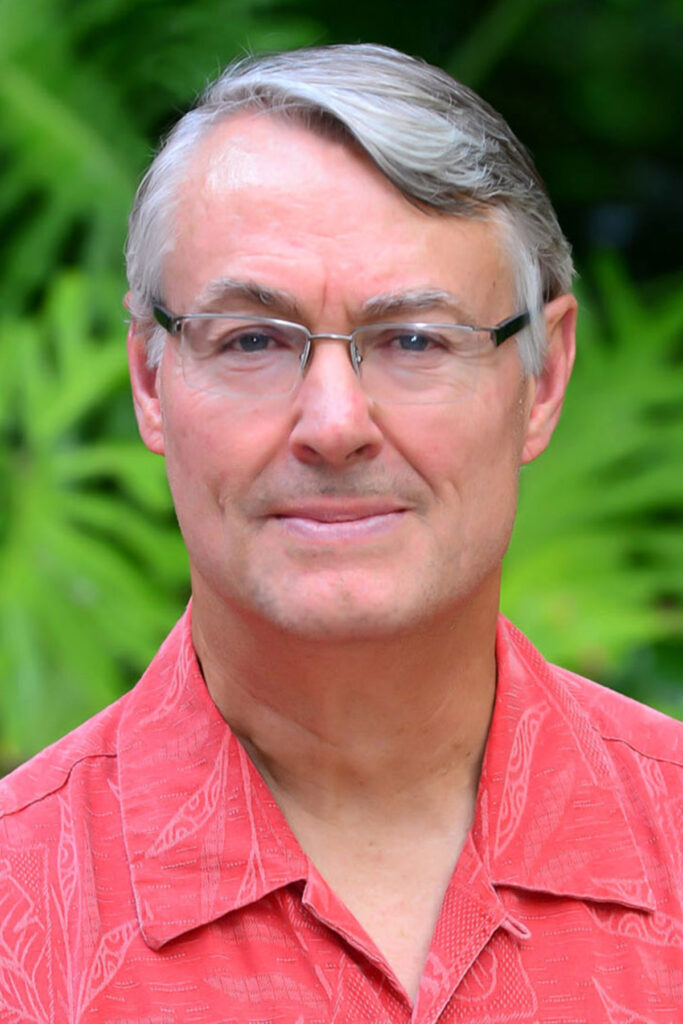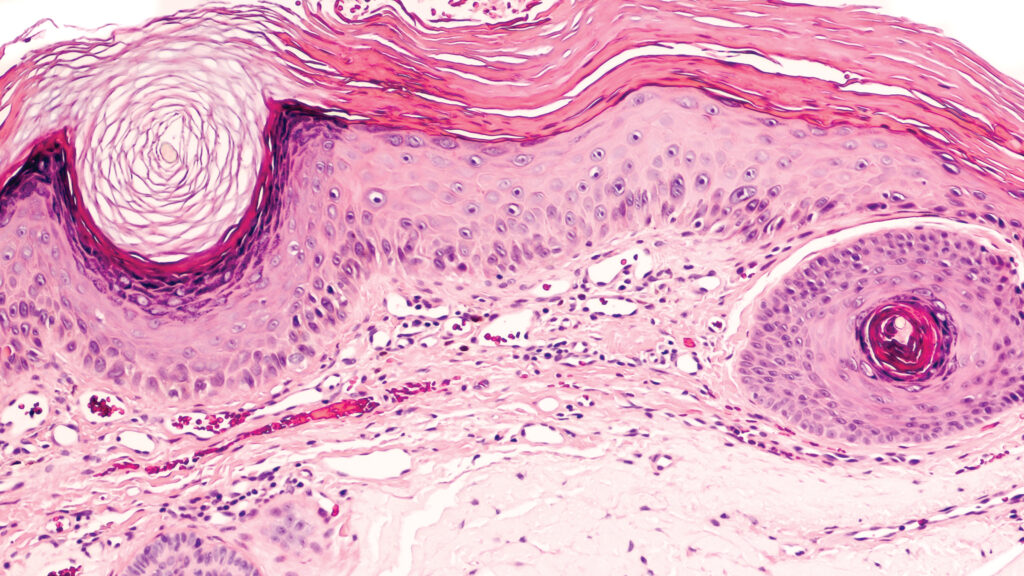George Martin, MD, with Bob Kronemyer

The molecule contained in tirbanibulin 1% ointment (Klisyri; Almirall SA) for treating actinic keratosis of the face and scalp is clearly a game changer, according to George Martin, MD, Medical Director at Dr. George Martin Dermatology Associates in Kihei, Hawaii.
“In a pooled analysis of results from phase 3 trials, this molecule resulted in 50% of patients clearing their actinic keratosis completely on the face and scalp, whereas 75% of patients cleared 75% of their disease,” Dr. Martin said. These results were twice as likely on the face as compared to the scalp. “This 75% success rate is more in alignment with real-world practice,” he said.
The trials also achieved an individual lesion clearance rate of more than 87%. “This is truly remarkable,” Dr. Martin said.
The molecule was developed by Athenex, “which creates truly unique oncologic molecules,” he said.
The topical therapy is applied once daily for 5 days, usually at nighttime for best compli- ance. “This translates into great compliance, not only because of its efficacy and short duration, but also because of the minimal irritation,” Dr. Martin said. The composite irritation score
(0 to 18) was, on average, 3, and severe local skin reaction occurred in less than 10% of patients. “This finding is also extraordinary,” he said.
In addition, application-site pruritus was 9% vs 6% for placebo. For pain, it was 10%, vs 3% for placebo.
Treatment will allow patients to maintain their work schedules and continue their normal lives, “without the long, protracted, cosmetically awful look they have with a 2-week on-off-on regimen of imiquimod cream or between 1 and 4 weeks of treatment with fluorouracil cream,” said Dr. Martin. “Similarly, photodynamic therapy (PDT), which is an excellent treatment, makes patients photosensitive and swollen for a few days and crusty for days. My patients usually take at least 1 week off work.”
However, there are some caveats to the medication. “This molecule is absorbed at very low levels into the bloodstream in some patients,” Dr. Martin said. “The mechanism of action is inhibiting alpha tubulin or breaking up the spindle apparatus of rapidly dividing cells and inhibiting cells that are rapidly growing. Alpha tubulin, though, is not limited to cell replication, but makes up the cytoskeleton and facilitates transport of molecules within the cell as well.”
Therefore, a woman of childbearing age should be treated with tirbanibulin with the same consideration as when treating with fluorouracil—only if she has a reliable form of contraception. “A lot of our actinic keratosis patients are over the age of 60, but I am treating young ladies who are 32 or 33 with the disease,” Dr. Martin said. “Certainly, age 30 to 50 is the space where we are noticing an increased incidence of actinic keratosis.”
The treatment field is also limited to 25 cm2, which is modeled after the ingenol mebutate gel studies of 25 cm2. “Of course, when we talk about a field therapy, we think about a full face or a full scalp,” Dr. Martin said. “Although tirbanibulin is approved for the treatment of face and scalp, the treatment parameters are 25 cm2, which is about the size of an individual’s palm.”
Hence, clinicians accustomed to 5% imiquimod sachets will need to spread tirbanibulin over a wider surface area. “There will be enough in the sachet to potentially treat the entire field surface, as we often do with 5% imiquimod sachets,” Dr. Martin said. “But does that mean that the tirbanibulin molecule will be somewhat diluted and potentially less efficacious than what we have seen in the original studies? That is unknown. Meanwhile, I encourage those who will be using tirbanibulin to start applying by spreading the ointment over the more severe actinically damaged areas.”
Because of the drug’s ease of use, Dr. Martin said that, if clinically indicated, it is appropriate to retreat a few months after the first application. “Clearance rates were measured at day 57 in the phase 3 trials, so I would probably consider retreatment if an incomplete response occurs after assessing the patient at 3 months,” he said. “Remember, actinic keratoses is a chronic disease. My patients have 1 or 2 cycles of field therapy each year, depending on their risk for nonmelanoma skin cancer.”
Dr. Martin believes tirbanibulin is probably the easiest drug to use for the treatment of field cancerization. “The strategies we use for fluorouracil cream can be applied to tirbanibulin,” he said.
A 1-year longitudinal followup study of tirbanibulin enrolled patients who had cleared 100% of their field at day 57, for which the number of baseline lesions was typically 5 to 8. “The Food and Drug Administration defines recurrences as any actinic keratosis that emerges in the treatment field within 1 year,” Dr. Martin said. “However, the study investigators were very specific in their mapping. They showed that, while 73% of individuals developed an actinic keratosis in the treatment field during the 1-year followup, many of the recurrences that were noted were actually new lesions, not initially treated lesions.”

After stratification, roughly 50% of patients who cleared their treatment area by initial day 57 remained clear for an additional year. And for patients who developed new lesions during the 1-year follow-up, at least two-thirds were limited to 1 or 2 new lesions.
A drug with promise
“The cosmetic impact on individuals who are treated with tirbanibulin should be pretty minimal,” he said. “I do not think we are going to have many callbacks, like we do with imiquimod, fluorouracil, and PDT. I look forward to using this molecule in my practice on my patients. Already, many of my patients with actinic keratosis who have been previously treated with these other therapies are ready to sign up.”
Dr. Martin is eager to observe 3-month follow-up results with tirbanibulin. “It should also be well covered by commercial insurances,” he said. “Medicare patients always present a challenge with brand-name medications. This will be no different. However, I know that Almirall, the company marketing this molecule, is making great strides to ensure that our Medicare patients have access to the drug.”
A safety study of a large field therapy area in excess of 100 cm2 to treat difficult areas such as the extremities or décolleté of the chest is currently under way.
Furthermore, Almirall is also in discussions to use tirbanibulin to treat squamous cell carcinoma in situ, “which is basically an expanded actinic keratosis, and secondarily the treatment of superficial basal cell carcinomas,” Dr. Martin said. “I think this molecule would be a great fit for both indications.”
Other disease states in cutaneous oncology might also benefit from tirbanibulin, according to Dr. Martin. “So this drug holds great promise for not only cutaneous skin cancers, but also potentially for other non-malignant growths such as warts,” he said. “We are eager to see the complete spectrum of what this molecule is capable of doing.”
DISCLOSURES
Dr. Martin serves on the scientific advisory board and/or is a paid consultant to Almirall, Bausch/Ortho, Biofrontera, LEO Pharma, and SUN/DUSA.


